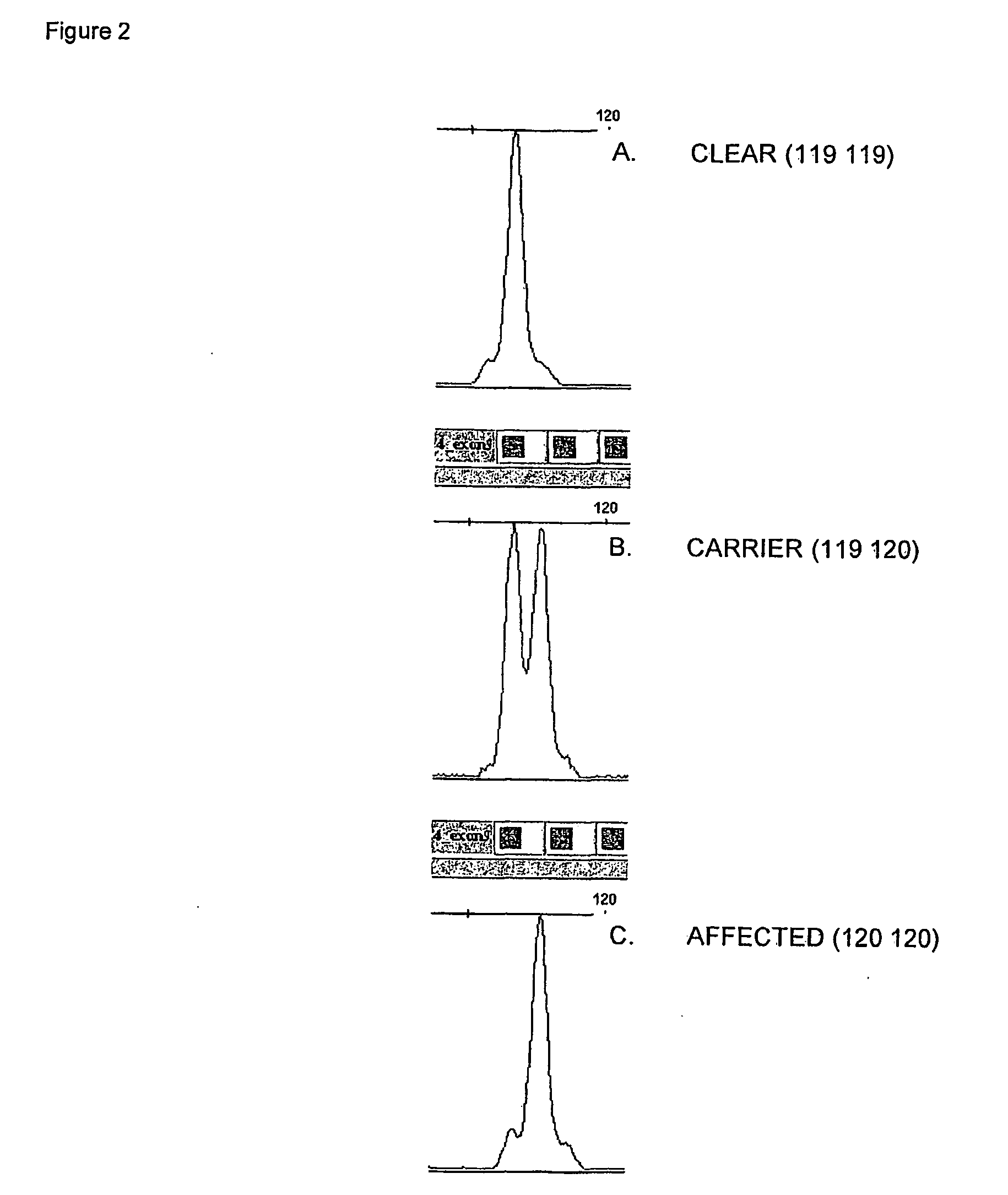Hereditary cataract status in canines based on hsf4 gene marker
a gene marker and hereditary cataract technology, applied in the field of genetic analysis of hereditary cataract, can solve the problems of hampered breeding of affected dogs by breeders, and achieve the effect of preventing or reducing the onset of h
- Summary
- Abstract
- Description
- Claims
- Application Information
AI Technical Summary
Benefits of technology
Problems solved by technology
Method used
Image
Examples
example 1
Provision of DNA Samples
[0135]For use in the following examples, 5 ml blood samples were collected and preserved in EDTA from dogs diagnosed by a veterinary ophthalmologist to be affected with hereditary cataract (HC) and from dogs known to be obligate carriers of HC (dogs clear of HC, but known to have produced offspring affected with HC). DNA was extracted using the Nucleon genomic DNA extraction kit (Tepnel, Manchester, UK).
example 2
Microsatellite Selection and Amplification
[0136]Canine orthologues of human and murine candidate genes selected from (http: / / www.ncbi.nlm.nih.gov / entrez / query.fcgi) were identified using the, ensembl orthologue prediction facility (http: / / www.ensemblorg / index.html). These canine orthologues were termed ‘canine cataract candidate genes’ (CCCG).
[0137]One megabase (Mb) of DNA sequence surrounding each CCCG was downloaded from the ensembl database and searched for CA and GA microsatellites. Two microsatellites adjacent and flanking each CCCG were selected and primers to amplify each microsatellite were designed using the Whitehead Institute primer design website (http: / / frodo.wi.mit.edu / cgi-bin / primer3 / primer3_www.cgi). An 18 by extension sequence (TGACCGGCAGCAAAATTG) was added to the 5′ end of the forward primers to allow amplification of a fluorescently labelled third primer for visualisation on ABI 3100 genetic analysers (Oetting W. S., et al. (1995). Linkage analysis with multiplexe...
example 3
Sequencing
[0139]PCR primer pairs were designed to amplify across each of the 13 exons and 80 bp of surrounding sequence of the canine orthologue of HSF4 (heat shock transcription factor 4). Each exon was amplified from genomic DNA from 2 Staffordshire bull terriers affected with hereditary cataract, 1 obligate carrier and 1 Staffordshire bull terrier predicted to be clear of hereditary cataract from genotyping data from the microsatellites associated with HSF4 (HSF4—5—85.24 and HSF4—5—85.60). PCRs were carried out in 12 μl reactions consist of 1.2 U Amplitaq Gold DNA polymerase (Applied Biosystems), 200 μM dNTPs (Amersham), 1.5 mM MgCl2 (Applied Biosystems), 1× Geneamp PCR Gold Buffer (Applied Biosystems), 0.83 μM forward and reverse primer (Proligo) and 10-20 ng template genomic DNA. GC rich templates were amplified in 10 μl reactions consisting of 1 U Hot Star Taq Polymerase (Qiagen, Crawley, West Sussex, UK), 300 μM dNTPs (Amersham), 1 μl of Q reaction buffer, 2 μl of Q solution,...
PUM
| Property | Measurement | Unit |
|---|---|---|
| temperatures | aaaaa | aaaaa |
| temperatures | aaaaa | aaaaa |
| temperature | aaaaa | aaaaa |
Abstract
Description
Claims
Application Information
 Login to View More
Login to View More - R&D
- Intellectual Property
- Life Sciences
- Materials
- Tech Scout
- Unparalleled Data Quality
- Higher Quality Content
- 60% Fewer Hallucinations
Browse by: Latest US Patents, China's latest patents, Technical Efficacy Thesaurus, Application Domain, Technology Topic, Popular Technical Reports.
© 2025 PatSnap. All rights reserved.Legal|Privacy policy|Modern Slavery Act Transparency Statement|Sitemap|About US| Contact US: help@patsnap.com


